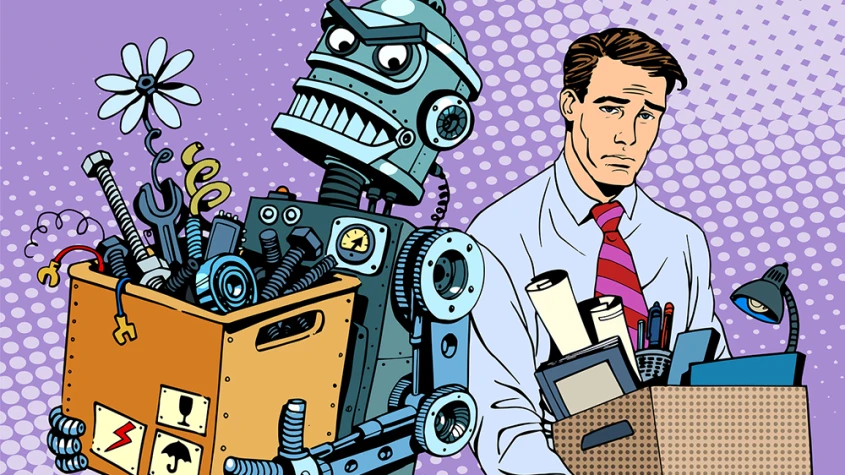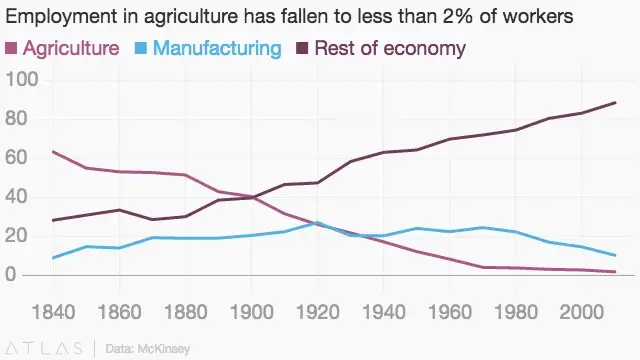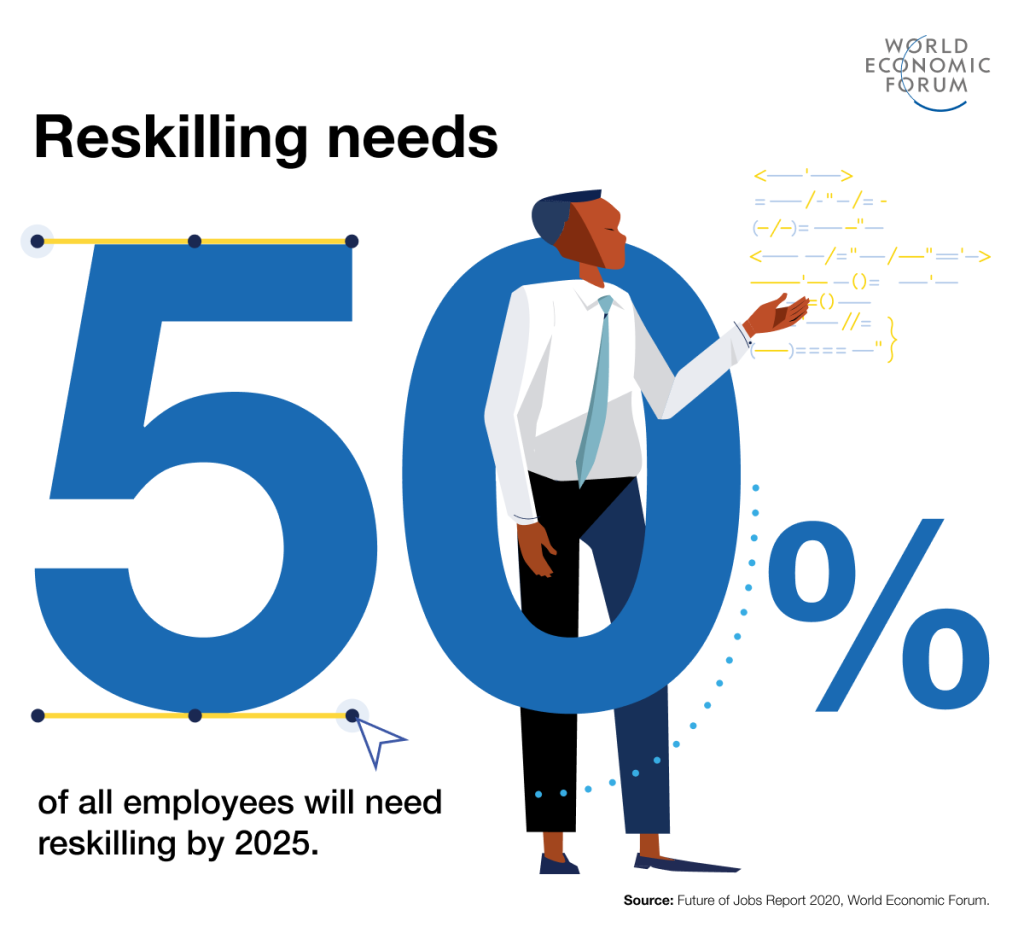
“The robots are coming for your job, too” – is the current mainstream outcry, or could we say paranoia? New artificial intelligence and robotic technologies are fueling fears that automation will cause widespread unemployment. The debate of automation causing potential mass unemployment has been hounding the AI community for the past decade. People tend to be afraid of technology that has the potential to change the future of the labor market.
One of the reasons that economists are skeptical is because much of the fear that has recently been stoked in the media is familiar. Every few decades, predictions about the “end of work” have pervaded public discourse, and they have always been wrong. There was a spike of automation anxiety in the late 1920s and ‘30s, when machines were starting to take over jobs on farms and in factories. We find ourselves in another era of automation anxiety right now. Is there still reason to be skeptical or is this time any different?
Technology is a Job Creating Machine
While most of the conversation about artificial intelligence and unemployment plus the job market focuses on automation’s ability to replace workers, it is worth discussing how AI might create jobs or help job seekers avoid unemployment.
Just a few decades ago, the internet created similar concerns as it grew. Despite skepticism, the technology created millions of jobs and now comprises 10% of US GDP. While this Fourth Industrial Revolution technologies driven by AI will continue to fundamentally change the world and the way we work and live, AI may not lead to massive unemployment. Instead, AI technology will create more jobs than it automates. In its “Future of Jobs Report 2020,” the World Economic Forum estimates that 85 million jobs will be displaced while 97 million new jobs will be created across 26 countries by 2025.
The majority of critics on AI disruption overlook the new industries and advancements that will flow from it. Technology and innovation creates more jobs than it destroys, including some you can’t imagine at the outset. To be fair, it is challenging to predict the types of jobs that will be available in the future (who would have thought that social media managers, digital marketers, YouTube content creators and app developers would exist before the invention of the Internet? ), but it seems alarmist to completely disregard the emergence of new fields and roles. A report by the Institute for the Future (IFTF) estimated that nothing less than 85 percent of the jobs that will exist in 2030 haven’t even been invented yet.
Another impact of higher production and lower costs is higher demand, which frequently results in a rise in employment in a particular sector. Technology raises productivity growth, which in turn boosts demand and creates jobs. Examples include a number of legal start-ups that aim to automate the duties of a paralegal by looking through vast quantities of case files and court records for pertinent information. This is made possible by advancements in natural language processing (NLP). At first glance, one could believe that this is the paralegal profession’s death knell. The Economist, however, adds that because paralegals can conduct better searches more quickly and affordably than before, there is a greater demand for them. This same price-supply-demand dynamic has played out countless times in the past. In short, everyone benefits.
The Historical Record: I think we’ve seen this film before
AI jobs alarmists will admit that history stands in stark opposition to their prognostications. The cycle of more economical production processes leading to increased wealth and higher standards of living has played out many times despite repeated dire warnings of impending mass unemployment with the latest innovation.

Technology has decreased the agricultural sector’s share of employment from over 50% in the mid-1800s (and over 90% in the early 19th century) to less than 2% today. The graph above demonstrates how employment has grown much more. Nearly all economic indices show an improvement in well being as the proportion of the people engaged in agriculture declines, with the highest improvements occurring in those regions where this is happening the quickest. This pattern has been observed all throughout the world. In other words, widespread technological disruption is nothing new, and it is currently occurring in many emerging countries, with positive results.
In conclusion, history offers some comfort regarding the effects of technology on employment. While new technology may be extremely disruptive for certain workers, if the past is any indication, creation will ultimately win over destruction.
We still want a human on the job : AI can do the mundane and dangerous parts
Recent (OECD) studies have examined specific, repetitive tasks instead of entire job roles in order to better understand how technology may be used to replace certain aspects of work. However, for the majority of jobs – including most positions currently held by humans – computers will not completely take over those responsibilities.
As AI technology continues to evolve, it will eventually take over many tasks which are generally seen as mundane and repetitious. It will automate many repetitive and sometimes dangerous tasks like data entry and assembly line manufacturing. The technology will also change the nature of work for many other jobs, allowing workers to focus on higher-value and higher-touch tasks that often require interpersonal interactions. These newly enhanced jobs will create benefits for both businesses and individuals who will have more time to be creative, strategic, and entrepreneurial.
Currently, AI does not possess emotional intelligence. It is not intelligent enough to do creative work. (at least nothing close to human creativity) Additionally, it is not capable of showing empathy and cannot think outside the box. And this, in most cases, is the key to the development of innovations. Human ingenuity, insight and contextual awareness are still key to making AI work.
Reskilling and upskilling
These newly created jobs will require new skills and necessitate significant investment in upskilling and reskilling young people and adults. Employment shifts can be painful. But businesses and governments can – and must – work together to address this transition and embrace the positive societal benefits of AI. In the next five years, half of all workers will require some upskilling or reskilling to prepare for changing and new jobs, according to the World Economic Forum. The rapid pace of technological change requires new models for training that prepare employees for an AI-based future. True upskilling requires a citizen-led approach focused on applying new knowledge to develop an AI-ready mindset. Employers should view upskilling and reskilling as an investment in the future of their organization, not an expense.

Companies should also collaborate with governments, educators, and nonprofit organizations on multi-sector upskilling and reskilling initiatives. Training benefits more than just employees and their employers, but also the economy and society. The World Economic Forum has launched the “Reskilling Revolution,” an initiative designed to train and future proof one billion workers by 2030. The campaign will involve government and business leaders working together to provide training in new skills that employees need for the future.
Conclusion
It cannot be denied that the impact and benefits of AI will likely not be shared equally. AI will lead to changes in the job market and potentially painful disruptions for some. What we believe is, these changes will not lead to disaster, but will eventually bring greater prosperity to most participants. The people whose jobs go away aren’t easily retrained for the new jobs and that can lead to anger and social unrest — and, in the short term, massive inequalities, across both geographies and groups of people. Businesses and governments must work together to ensure that as many people as possible can benefit and the digital divide does not increase and exacerbate existing inequalities.
While some see a dystopian future, it’s more likely that AI will ultimately have a good social impact than a negative one in the long term. We can only get ready for this future and benefit from AI by investing in high-quality, holistic education and upskilling opportunities together with multi-sector initiatives.


